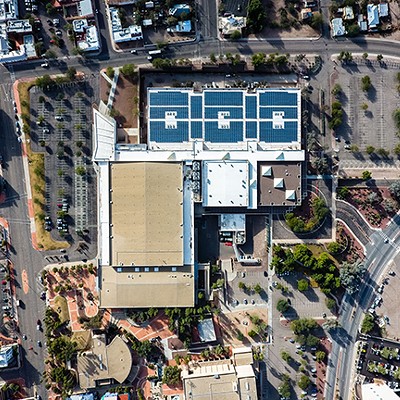The first mosquito of spring is not a happy event, and not just because the insects are a pain, and, we're told, a danger. (Aside from encephalitis--not your most desirable disease--you can start worrying about malaria and dengue fever. And, for our furry pals, there's--ta da!--heartworm.) The mosquitoes are also just plain depressing to those of us who've been here awhile.
Personally, I resent them in the same way that I hate the ever-increasing flock of pigeons on my street and the fountain grass swarming over the hills and up the canyons. I try not to notice, but find it impossible to ignore the proliferation of weed species, evidence everywhere I look that Tucson is getting worse.
The city sprawls out and out, and the infrastructure lags behind the scraping and building, and more and more people move here because this is the cheapest darn place on earth to buy a house--what a great system! Those of us who live here already subsidize the newcomers! Even though there's not an adequate water supply, considered everywhere else on Earth to be an urban necessity! In the process, the scruffy, likeable place that was Tucson vanishes while we watch.
Back to the mosquitoes. For my first 20-plus years here, I hardly saw one. Long ago, apparently, the little monsters were a problem, but that was really back when--before the cows stripped off the grasses and the rivers stopped running and the cottonwoods along the Santa Cruz and Rillito withered and Tucson became the dusty creosote flat we all know and love.
Since the indigenous mosquito population was before my time, it's outside the scope of my nostalgia. What does make me sad and cranky, though, is the fact that my husband and I can no longer have breakfast and dinner outside in the hot months. Six or seven years ago, mosquitoes such as we had never seen drove us inside and behind the screens, and have kept us there. Now, being typical Southern Arizonans, we're resigned to yet another loss about which we can do nothing. (By looking up Aedes aegypti mosquito in the Star--motto, "Shortest attention-span in the West!"--you can map the initial dismay and typical local subsidence into supine depression. There was a flurry of stories in 1995-97 as people started getting chewed up--"Dengue-spreading mosquitoes pose no hazard, officials say," September, 1995--a couple follow-ups over the next two or three years-- "Mosquito-borne dengue moving toward Arizona," April, 1997--and then an alarming headline in 1999, "Mosquitoes in city swamp found to carry encephalitis," September, 1999. Then, silence.)
Sitting outside in the cool hours of the day was the sort of small, solid pleasure that, when added to many other little things, constitutes quality of life. Whatever pushed A. aegypti over the tipping point and into robust, permanent infestation--shipments of water-harboring used tires from Mexico, climate and environmental change, the UA's slaughter of thousands of bats under the bleachers of Arizona Stadium--the bugs have made our yard unusable during the hot months. To think people are still moving here for sunsets. Someone should tell them.
I used to actually brag to out-of-towners about how unexpectedly comfortable life in the weird Sonoran desert was--oh, yeah, we've got all these flamboyant, supposedly terrifying critters like tarantulas and scorpions, but hardly any species that bother people. Few houseflies, no chiggers or fire-ants or ticks, and never a mosquito. And it was true. (Now a neighborhood in Phoenix has roof rats. Can Sam Hughes be far behind?)
The mosquito in the bathroom is, in every way, a small thing. Apart from the brown cloud hanging over the ravaged Northwest Side, the old, established trees around town that turned out to be dead this spring because the water table has dropped out from under them, the condition of our roads and the traffic, the random homicides and Third World educational system, pathetic social services, corrupt government and the rest of what we put up with to live here, Tucson's weed species problem is nothing--just more evidence of the ongoing degradation.
It would be no big deal, except that this is where we spend our lives: in our houses and on our patios and driving around town. Every day, we have less reason to love the place in which we live. And more reason to whine.












